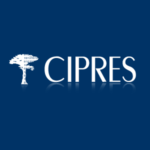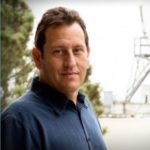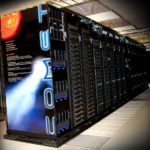Ilkay Altintas from the San Diego Supercomputer Center gave this talk at the HPC User Forum. “WIFIRE is an integrated system for wildfire analysis, with specific regard to changing urban dynamics and climate. The system integrates networked observations such as heterogeneous satellite data and real-time remote sensor data, with computational techniques in signal processing, visualization, modeling, and data assimilation to provide a scalable method to monitor such phenomena as weather patterns that can help predict a wildfire’s rate of spread.”
BioBurst: Leveraging Burst Buffer Technology for Campus Research Computing
In this video from the DDN User Group at SC17, Ron Hawkins from the San Diego Supercomputer Center presents: BioBurst — Leveraging Burst Buffer Technology for Campus Research Computing. Under an NSF award, SDSC will implement a separately scheduled partition of TSCC with technology designed to address key areas of bioinformatics computing including genomics, transcriptomics, […]
Comet Supercomputer Assists in Latest LIGO Discovery
This week’s landmark discovery of gravitational and light waves generated by the collision of two neutron stars eons ago was made possible by a signal verification and analysis performed by Comet, an advanced supercomputer based at SDSC in San Diego. “LIGO researchers have so far consumed more than 2 million hours of computational time on Comet through OSG – including about 630,000 hours each to help verify LIGO’s findings in 2015 and the current neutron star collision – using Comet’s Virtual Clusters for rapid, user-friendly analysis of extreme volumes of data, according to Würthwein.”
Exploring Evolutionary Relationships through CIPRES
Researchers are exploring the Tree of Life with the help of the CIPRES portal at the San Diego Supercomputer Center. “As a community-built resource, CIPRES addresses what the scientists really want and need to do in the real world of research,” said Mishler. “Aside from increasing our understanding of the evolutionary relationships of this planet’s diverse range of species, the research also has yielded results of critical importance to the health and welfare of humans.”
Fighting the West Nile Virus with HPC & Analytical Ultracentrifugation
Researchers are using new techniques with HPC to learn more about how the West Nile virus replicates inside the brain. “Over several years, Demeler has developed analysis software for experiments performed with analytical ultracentrifuges. The goal is to facilitate the extraction of all of the information possible from the available data. To do this, we developed very high-resolution analysis methods that require high performance computing to access this information,” he said. “We rely on HPC. It’s absolutely critical.”
Researchers Use TACC, SDSC and NASA Supercomputers to Forecast Corona of the Sun
Predictive Sciences ran a large-scale simulation of the Sun’s surface in preparation for a prediction of what the solar corona will look like during the eclipse. “The Solar eclipse allows us to see levels of the solar corona not possible even with the most powerful telescopes and spacecraft,” said Niall Gaffney, a former Hubble scientist and director of Data Intensive Computing at the Texas Advanced Computing Center. “It also gives high performance computing researchers who model high energy plasmas the unique ability to test our understanding of magnetohydrodynamics at a scale and environment not possible anywhere else.”
Dr. Ilkay Altintas to recieve ACM SIGHPC Emerging Woman Leader in Technical Computing Award
Today SIGHPC announced that Ilkay Altintas is the inaugural winner of the ACM SIGHPC Emerging Woman Leader in Technical Computing Award. “I am thrilled that Dr. Altintas has been selected to receive the inaugural SIGHPC Emerging Woman Leader in Technical Computing Award,” commented Dr. Jeffrey Hollingsworth, interim CIO at the University of Maryland and Chair of SIGHPC, in reaction to the award committee’s decision. “Dr. Altintas’ work enables technical collaboration among different groups; this is critical not only for high performance computing, but science in general. With leaders like Dr. Altintas, the future of our field is in good hands.”
Christopher Irving Named Manager of HPC Systems at SDSC
Today the San Diego Supercomputer Center announced that Christopher Irving will be the new manager of the Center’s High-Performance Computing systems, effective June 1, 2017. “Christopher has been involved in the many facets of deploying and supporting both our Gordon and Comet supercomputers, so this appointment is a natural fit for all of us,” said Amit Majumdar, director of SDSC’s Data Enabled Scientific Computing division. “He also has been coordinating closely with our User Services Group in his previous role, so he’ll now officially oversee SDSC’s high level of providing HPC and data resources for our broad user community.”
Comet Supercomputer Doubles Down on Nvidia Tesla P100 GPUs
The San Diego Supercomputer Center has been granted a supplemental award from the National Science Foundation to double the number of GPUs on its petascale-level Comet supercomputer. “This expansion is reflective of a wider adoption of GPUs throughout the scientific community, which is being driven in large part by the availability of community-developed applications that have been ported to and optimized for GPUs,” said SDSC Director Michael Norman, who is also the principal investigator for the Comet program.
Register Now for the SDSC Summer Institute on HPC
“This year’s workshop continues SDSC’s strategy of bringing high-performance computing to what is known as the ‘long tail’ of science, i.e. providing resources to a larger and more diverse number of modest-sized computational research projects that represent, in aggregate, a tremendous amount of scientific research and discovery. SDSC has developed and hosted Summer Institute workshops for well over a decade.”











